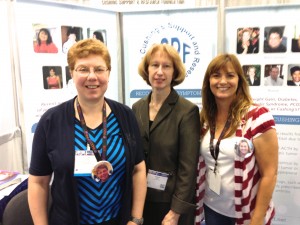The annual meeting of the Endocrine Society was held June 15–18 in San Francisco, CA. Once again, the CSRF had a booth on the exhibit floor. The booth was staffed by Karen Campbell, Ellen Whitton, Elissa Kline, Danielle Ziatek, and Libby Vianu Unfortunately, our booth was in an area of the exhibit hall that did not see heavy traffic, and a large gas leak closed the Moscone Center for most of Sunday afternoon so we lost some exhibit time; however, we still had an opportunity to speak with many members of our Medical Advisory Board and other physicians and nurses. We have reserved our booth space for ICE/Endo 2014 in what looks like an excellent location. The 2014 exhibit, to be held on June 21–24 in Chicago, IL, is a joint meeting with the International Society of Endocrinology.
A Satellite Symposium, “Cushing’s Disease: When Surgery Fails,” was chaired by Dr. Ashley Grossman, UK, and included talks on the “Pitfalls in the Testing and Diagnosis of Hypercortisolemia” by Dr. Lynnette Nieman, National Institutes of Health, Bethesda, MD; “When Surgery Doesn’t Work—Radiation Modalities” by Dr. John Suh, Cleveland Clinic, OH; and “Advances in Medical Therapy” by Dr. Stephan Peterseen, ENDOC Center for Endocrine Tumors, Germany. Meet the Professor sessions were presented on “Cushing’s Disease: Evaluation and Management” (Dr. Richard Feelders, Erasmus MC, Netherlands) “Adrenal Nodules” (Dr. Richard Auchus, University of Michigan, Ann Arbor, MI), “ACTH Independent Macronodular Adrenal Hyperplasia: Diagnosis and Management” (Dr. Andre Lacroix, University of Montreal, Canada), “Aggressive Pituitary Tumors” (Dr. John Wass, Oxford University, UK), and “Pituitary Incidentalomas” (Dr. Laurence Katznelson, Stanford University, CA). The Endocrine Nurses Society also included talks on Cushing’s. “An Update on Cushing’s Disease” was presented by Dr. Beverly Biller, and Karen Liebert, RN, BSN, from Massachusetts General Hospital, Boston, MA.
An oral presentation, “Characterization of Autoimmune Disorders in Patients with Endogenous Cushing’s Syndrome: A Multicenter Italian Study” (Guaraldi et al.) discussed the evolution of autoimmune disorders in pre-, active, and post-Cushing’s patients compared to patients with other types of pituitary tumors. Approximately 30% of Cushing’s patients and 30% of the control group experienced autoimmune disorders. Most of the autoimmune disorders in Cushing’s patients appeared after remission of Cushing’s.

Left to right: Danielle Ziatek, Karen Campbell,
Elissa Kline, Ellen Whitton
during the Moscone Center evacuation
In a featured poster session, Wagenmakers et al. presented “Persistent Centripetal Fat Distribution and Metabolic Abnormalities in Patients in Long-term Remission of Cushing’s Syndrome.” Their study showed that 5 years after cure, the 58 Cushing’s patients had increased waist circumference, smaller thigh circumference, more abdominal fat, and more adverse markers of cardiovascular risk than their age, gender, and body mass index–matched controls.
Several posters focused on the prevalence of Cushing’s. Broder et al. estimated the prevalence of Cushing’s disease, using two large insurance claims databases (2009 to 2010) and using inclusion criteria of a diagnosis of Cushing’s syndrome and pituitary surgery with two prior years of disease-free status. Estimation of the incidence rates per million person year for 2009 was 7.6 and 6.2 in 2010, or about 2,000 cases per year in the United States. Brzana et al. conducted a retrospective analysis of 50 patients with Cushing’s disease and found that 26 of them had previously been treated for polycystic ovary syndrome (PCOS). Both PCOS and Cushing’s produce symptoms of obesity, insulin resistance, abnormal periods, hirsutism, and acne. While PCOS is more prevalent than Cushing’s, it is important that a diagnosis of Cushing’s is not overlooked in this patient population. Javorsky et al. attempted to answer the question, “How many undiagnosed Cushing’s patients undergo bariatric surgery?” See the article on page ? that summarizes the findings.
Several posters focused on the use of medications in Cushing’s. Adelman et al. looked at the quality of life of Cushing’s patients before and during treatment with mifepristone (Korlym) and found that treatment significantly improved the overall quality of life and individual symptoms, including bruising, socialization, physical appearance, and sleep. Fleseriu et al. studied patients with Cushing’s disease who were treated long term with mifepristone. Because mifepristone blocks cortisol action at the cellular level, ACTH levels were actually shown to rise with treatment compared to baseline, but only 4 (three macroadenomas, one microadenoma) of 17 patients with visible tumors on MRI were shown to experience tumor progression during treatment. Thus, elevated ACTH levels do not necessarily mean an increase in tumor size. The 19 patients without visible tumors at baseline did not show visible tumors during treatment. MRIs should be conducted periodically in patients treated with mifepristone, particularly those with macroadenomas. Pivonello et al. presented the results of a study on symptom improvement in patients treated with pasireotide (Signifor) for 6–12 months and found that symptoms, such as blood pressure and weight gain, improved even in patients who did not have normal 24-hr urine cortisol. MacKenzie-Fedar et al. reported on two patients who had been successfully treated with pasireotide for 5 years. After an initial blood sugar increase and treatment with metformin, their blood sugar was controlled with diet alone. Page-Wilson et al. reported on one patient with Cushing’s disease due to a very aggressive pituitary tumor. The patient was treated with capecitabine (Xeloda) and temozolomide (Temodar), and at 6 months, tumor size was decreased by 50% and at 12 months was not visible on MRI. The patient has remained disease-free for 29 months after 23 cycles of treatment.
It is impossible to cover all of the many excellent presentations regarding Cushing’s. If you would like to read the abstracts, you can do so at https://www.endocrine.org/; select Meetings, then ENDO 2013.





Sorry, comments are closed for this post.